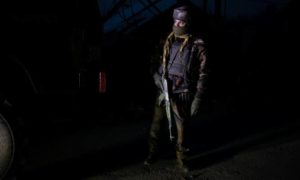It took the Indian judiciary 23 years to declare five people, including four Kashmiris, innocent in a series of bomb blast cases that rattled Delhi and Jaipur during the mid-nineties. Back home after wrongful imprisonment, the lately released captives are now bracing themselves for the unsure life ahead of them.
After about a quarter century that he spent in different dungeons across India, Abdul Gani Goni, a doomed man, finally returned home as a traveller with a lost map.
It took him a while to recognise his birthplace, Parsi Mohalla’s lanes and bylanes. He had last seen his hometown Bhaderwah, in district Doda, as a young man full of dreams and aspirations. But now, he has come back as a blank old man, bereft of memory, familiarity and acquaintance.
23 years is a long time and Goni’s mannerism makes no bones about it.
No matter how hard he tried to salvage the cherished part of his Bhaderwah in his mind, this former teacher ended up trouncing the memories of his homeland in the face of hostile prison life. Besides, Bhaderwah has significantly evolved in last 23 years, during which Goni was caught in an arduous time freeze and that’s probably why he felt like a stranger upon his homecoming.
Back in 1996, the young teacher had traversed the same lanes to be with a Tableegh-e-Jamaat, en route Gujarat, to spread the word of Allah. At a tea-stall in Surat, he was arrested for the crime, he said, he never committed.
Although Goni looks sanguine, life after his wrongful imprisonment and punishment has become a void. He knew a different routine before he became a jailbird. But now, as Goni surmises it, he has arrived in an era where everything is fast and tech-driven. The nostalgic, sluggish pace of life has waned, so has the old worldview.
Apart from new possibilities, old familiarity has also vanished. Both his parents, who died longing for him, are now buried in his clan’s ancestral graveyard.
“I’ve seen the fate of prisoners who come out after spending a lifetime in jails,” said Goni’s relative with a long face. “They suffer unimaginably in the absence of a rehabilitation mechanism after their prison life. They must be engaged and treated properly so that they won’t think themselves as misfits in their post-prison life.”

Abdul Gani Goni.
These words are also ringing in Srinagar, where Goni’s three jailmates were released on the same date—July 23, 2019, after 23 years.
While all of them carry a wrecked world of horrendous memories, no one wants to revisit the nightmare that made them scapegoats of looming suspicion. But what has remained is the spirit for life — a somewhat fractured resolve for a new beginning which seems devoid of a sense of retribution.
As of now, tears, wails and smiles are momentarily lifting the 23-year-long imposed gloom in their homes.
Sitting amidst the grievingly festive mood in his home in Srinagar, Mirza Nisar now wonders about many things—his bald head, the not-so-familiar world, the new faces, the old acquaintances and the advent of technology that now seems to dictate life and its priorities.
Nisar might be wearing a beaming smile, but his body language reminds one of Morgan Freeman’s celebrated character in the critically-acclaimed movie—The Shawshank Redemption.
Once the longtime prisoner sets his foot out in the changed world, he finds it quite hard to adjust. A look into Nisar’s eyes reflects the staggering reel moment in the real world.
Indeed, 23 years of incarceration is a lifetime of torture that can mortify any person, and Nisar makes no exception.

Mirza Nisar. (Photo credits: The Wire)
He now struggles to talk in his mother tongue, Kashmiri. Among the moist-eyed visitors pouring in his home are his childhood playmates. The freeman struggles to beseech the buried memory of his language to strike some familiarity with them.
“The night before our release, we couldn’t sleep or eat,” said Nisar who was just 16 but shown to be 19 on police records when arrested. “The anticipation, and paper work, seemed to go on forever.”
Now 39, he says, he would like to get married and try to make a fresh start.
His jailmate Lateef Ahmed Waja is also looking forward to the same life now. He wonders if any woman will ever accept his bald head and weary soul.
The day they were released, Lateef had to be hospitalised due to the wounds that had been inflicted on him in a jail fight.
“I was beaten by the jail staff,” he alleges. “They beat me with batons.” His head is bandaged and his legs bear injury marks.
During his detention period, Lateef’s father went to meet him at Jaipur. But after a week, he died in Srinagar. Such moments and memories are now haunting these recently released captives but Lateef is hopeful to make a new beginning in life just like Ali Bhatt.

Lateef Ahmed with his bandaged head.
On reaching Srinagar, 48-year-old Ali visited his ancestral graveyard to offer prayers for his departed parents’ souls. His heartrending reunion with his long-fallen silent parents—who withered in his wait—trended on social media and gave a glimpse of the tormented fate of another Kashmiri caught in the cycle of hostility and suspicion.
“We were innocent but the Delhi Police did everything to frame us,” Ali said, while crying his heart out at his parent’s resting place. “We were made to sign blank papers and confess to things we never did.”

Ali Bhatt at his parents’ graves.
Their ordeal had started with an actual bang.
On May 21, 1996, a deadly car bomb was detonated in Delhi’s crowded Lajpat Nagar, killing 13 and injuring 39. The explosion pulverized six cars and flames swept the shops near the site.
Next day, at 4 pm, a bus carrying passengers from Bikaner to Soron via Jaipur was blown up in Samleti village near Dausa, killing 14 and injuring 37 – figures that were uncannily close to the previous day’s numbers.
What followed was a long series of investigation, interrogation and trials.
On August 26, 1996, the Delhi Police filed a chargesheet in a Delhi court against the ten accused. They also gave a list of 201 witnesses. Simultaneously, in Rajasthan, the bus conductor filed an FIR with Mahwa police (in Dausa district), an event which was succeeded by a call that declared a defunct militant outfit’s hand in the blast.
Between December 1996 and January 1997, the authorities claimed to arrest all the suspects thus beginning a painfully prolonged quest for substantiating their charges against the accused.
Among them were Lateef Ahmed (42), Ali Bhatt (48), and Mirza Nisar (39) from Srinagar, Abdul Goni (57) of Bhaderwah and Rayees Beg (56) of Agra. The Agra resident had been incarcerated since June 8, 1997, while the others were imprisoned between June 17, 1996 and July 27, 1996.
During their trial, they were allegedly linked to the militant group, Jammu and Kashmir Islamic Front.
But little did the world know that before their wrongful arrest, Ali had a carpet business, Lateef used to sell Kashmiri handicrafts in Delhi and Kathmandu, Nisar was a Class IX student and Goni used to run a school.
Accused in the Lajpat Nagar case, they were arrested after police started tracing phone calls made by the suspects, who phoned media houses to claim responsibility for the blast. Nine of the ten accused were from Jammu and Kashmir. The chargesheet had also said that the men were involved in the Sawai Man Singh Stadium blast in Jaipur in 1996.
Delhi’s district court framed charges of murder, attempt to murder, anti-national activities and under the Explosives Act on November 20, 2000.
The accused claimed innocence.
After almost thirteen years of legal dilly-dally, the district judge transferred the case to the court of Additional Sessions Judge SP Garg where it was finally heard on September 7, 2009 and vindication was given to the four Kashmiris in November of 2012 – only to be implicated in the Samleti blast case.
The case went on and they were shuffled between Tihar and Jaipur.
Only after the passage of 23 years, that left them and the tax-payers’ honest remittances spent, the court announced them innocent on Tuesday, 23rd July 2019.

From left: Mirza Nisar, Lateef Ahmed, Rayees Beg, Ali Bhatt and Abdul Goni after their release from Jaipur Jail. (Photo: Indian Express)
“It’s a rebirth for these captives who were punished for being Kashmiris and Muslims,” says Lateef’s relative. “There’s a long life in front of them. The society as well as the system has to come together to embrace and help them to make a fresh start.”
But given how former Kashmiri prisoners are living, many are paranoid about the future of these four. The case in point is that of Syed Maqbool Shah.
Shah arrested for the same reasons, languished in jail for 14 years after which he was rendered unskilled and unfit for this cut-throat world. Promised a job by the establishment in JK, he had to endure a long wait till its fulfillment.
Severe lapses in the investigation process for which the Delhi High Court slammed Delhi Police, the unjustifiable delay in trial, the flabbergasting nonchalance for their rehabilitation, throws the glaring image of the inhumane approach.
Now that the ‘accused’ have been proved innocent, who are the ones actually responsible for the ghastly explosions? When will the victims of the blasts and the victims of this ‘system of justice’ be ever compensated for all that they have lost because of the state’s failure?
Meanwhile, Pragya Thakur, arrested for the Malegaon blasts in 2008 but let out on bail in 2017, not even acquitted and still facing trial under UAPA, sits in India’s legislative house as an elected MP and ridicules the 300 million people suffering from poor or no sanitation.
Like this story? Producing quality journalism costs. Make a Donation & help keep our work going.






